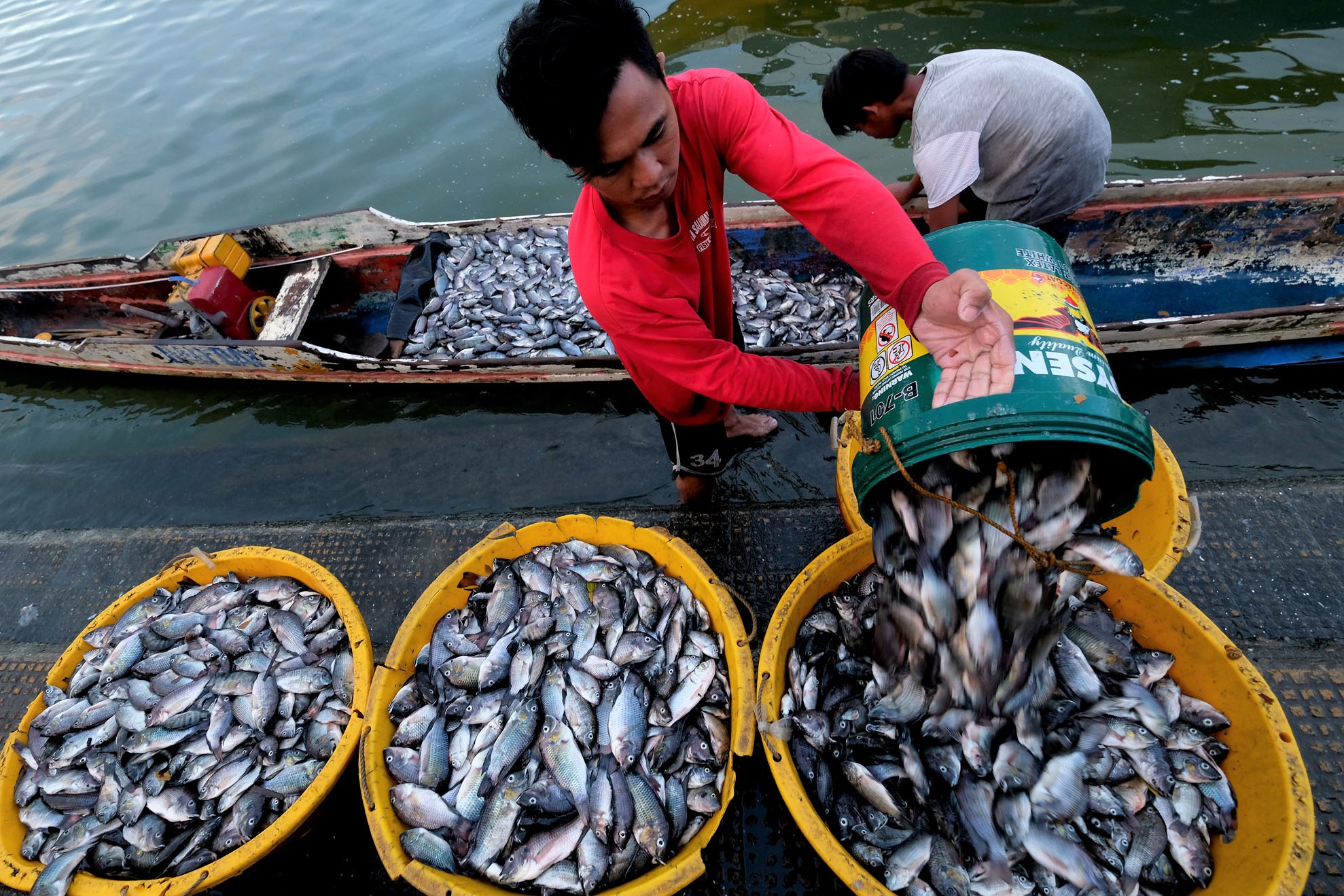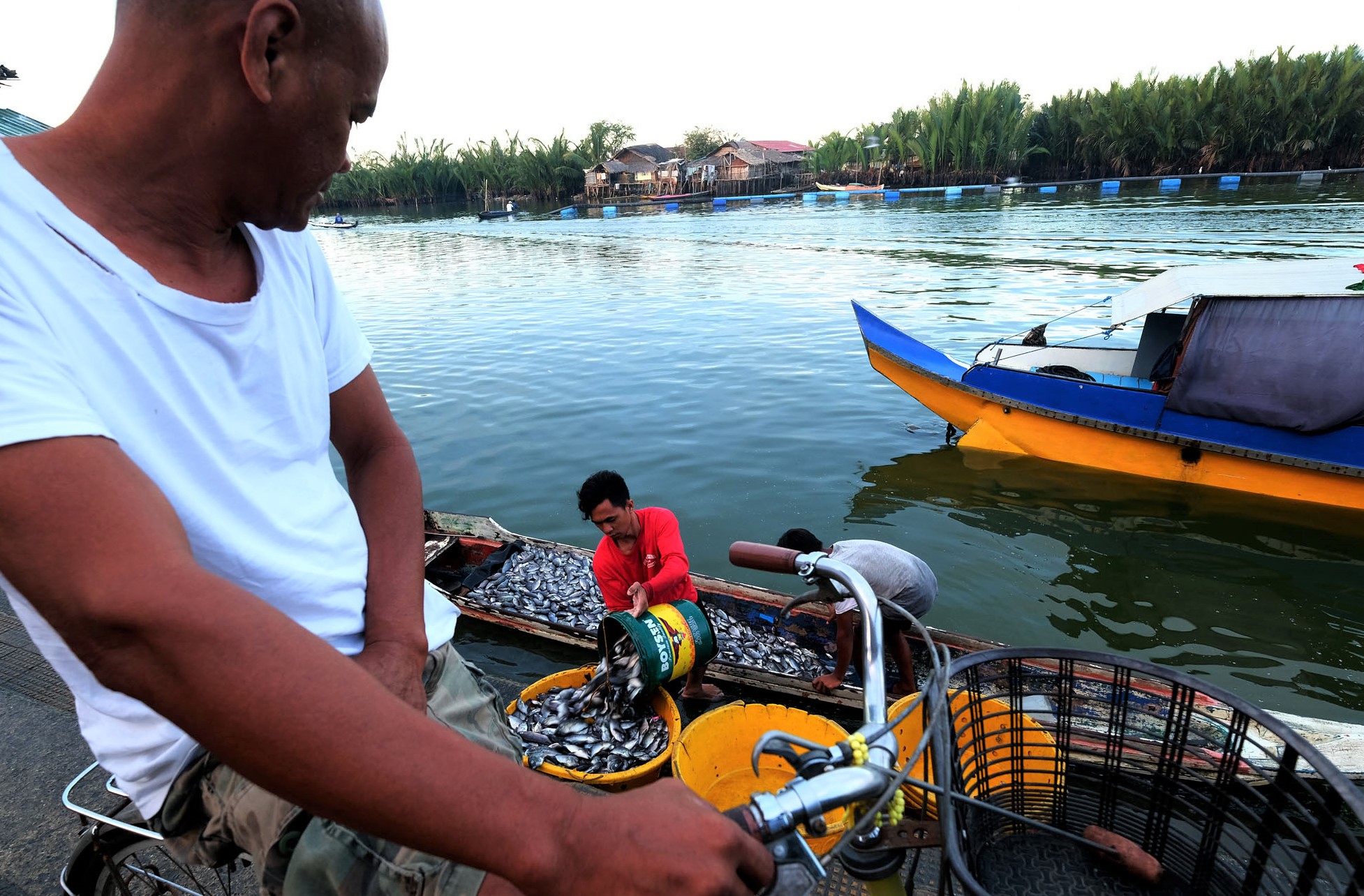Text by Henrylito D. Tacio
Photos by Rhoy T. Cobilla
Unlike the political commodity rice, fish are neglected when it comes to reporting in the media – except only where there is a fish kill. Fish, touted as “the last wild meal in the human diet,” are “poor man’s source of protein.”
The average Filipino eats 98 grams of fish per day and 36 kilograms of fish per year, reports the Philippine Statistics Authority (PSA). Fish is supposed to be cheaper than beef, chicken, and pork.
“During the past decades, the people have enjoyed the abundance of the Philippine marine fishery resource,” said a position paper from Philippine Economic, Environmental and Natural Resources Accounting (PEENRA).
“Ask the old fisherfolks how they culled their harvests. Many of them would say that fish sized with less than a foot rule will automatically be thrown back to the water. Back then, they even had the luxury to choose the most palatable fish among the wide variety of species thriving in a particular fishing ground.”
That was in the past. The current situation of fisheries in the country is rather bleak. In fact, it may not have enough fish to feed its growing population soon. For the past years, the country’s municipal and commercial catch of fish have dramatically declined.
Let’s take the case of a study conducted by the WorldFish Center some years back in Davao Gulf. A collaborative effort by various government agencies, the decade-study looked at the volume and quality of the harvests of 10 commonly fished species in the gulf: matambaka, tamban, moro-moro, caraballas, bilong-bilong, lapu-lapu, danggit, molmol, talakitok, and maya-maya.
Except for “maya-maya,” the harvest numbers for the species have been falling. “At the current rate of decline,” the study surmised, “the caraballas, bilong-bilong, molmol, and danggit may all disappear completely from Davao Gulf within a decade,” the study said.
Some consumers are already feeling the effect. Jeannyline T. Arriaga, from Bansalan, Davao del Sur, is a doting mother. She usually wakes up early in the morning to prepare breakfast for her two children, who are going to school. Generally, she cooks rice and fish.
Lately, however, she observes that the fish she usually buys at the public market has become scarcer. In fact, there are days when she could not find any, so she buys another kind of fish. Her two children complain because they don’t like the new kind of fish she serves to them.
Jeannyline also notices that if ever the fish she likes is available, they are becoming smaller. “Fish are not only getting scarcer these days but they are becoming expensive, too,” she points out.
A survey by the Social Weather Stations commissioned by Oceana in 2017 found that 82% of Filipinos believe fish sold in the markets is more expensive now compared to 10 years ago. Meanwhile, 54% of respondents said the size of fish has become smaller, and 55% said they found fewer varieties of fish in local markets compared to a decade ago.
Whatever happened? The Philippines, with some 220 million hectares of territorial waters, ranked 8th among the top fish-producing countries in the world in 2014. Now, fish production is waning.
The majority of the fishing grounds in the country are overfished. “Today, fishermen could hardly have fish to catch,” said Dr. Salome Bulayog, an associate professor of the Department of economics at the Visayas State University. “Fishermen have to spend longer to catch a kilogram of fish; some even have to go farther from the shore.”
The present administration of Ferdinand Marcos, Jr. is batting for food self-sufficiency by increasing production in the country. But with rising costs for fuel and agricultural inputs such as fertilizers, pesticides, and feed ingredients, how can these be possibly achieved?
In the past, importation seemed to be the answer to the problem. For instance, when the production of “galunggong” (round scad) declined from the seas, the country imported fish from China, Taiwan, and Vietnam to augment local supply.
“With our country’s growing population, there is a need for further increasing fish production to cope with the demand,” said Dr. Rafael Guerrero III, a fishery expert who once headed the Philippine Council for Marine and Aquatic Resources Research and Development. “How can the aspiration for self-sufficiency be achieved?”
The Bureau of Fisheries and Aquatic Resources (BFAR), an attached agency of the agriculture department, is given the task by President Marcos. Just recently, it has laid out plans on how the country can boost local fish production and minimize the need for fish importation.


In a statement, the BFAR laid out its catch-up to ensure fish sufficiency in the country, including innovation, modernization, and intensification of the fishery sector. Right now, it is trying to address the projected annual deficit of food fish supply estimated at 44,000 metric tons this year. “This is more than one percent short of what is needed to attain full sufficiency,” the fishery bureau pointed out.
Dr. Guerrero, an academician with the National Academy of Science and Technology (NAST), agreed with BFAR’s idea that the country can be fish self-sufficient through aquaculture and mariculture.
Both are related to raising aquatic products under controlled conditions. Aquaculture and mariculture may have the same objectives, but they are different in the sense that the former is related to growing fish in freshwater, and the latter pertains to seawater.
In the Philippines, the top farmed fishes are milkfish (also known as bangus) and tilapia. In 2021, production for the two species were 446,380 metric tons and 340,070 metric tons, respectively.
“Milkfish are farmed in brackishwater ponds, freshwater pens and sea cages while the tilapia is grown in freshwater ponds and freshwater floating cages,” Dr. Guerrero said. “For mariculture, the culture of milkfish and other marine fishes such as grouper, pompano, rabbitfish and the red tilapia hybrid in floating cages is being done in the coastal waters of our country.”
According to Dr. Guerrero, several mariculture parks – or marine areas similar to industrial parks on land – have been established by the BFAR in many regions of the country in cooperation with local government units.
Currently, more than 50,000 hectares of mariculture areas have already been established in the country. The BFAR has identified an additional 200,000 hectares of coastal waters suitable for expansion. “Our country has more than 26 million hectares of coastal waters,” Dr. Guerrero said.
If the country has to expand its mariculture parks, Dr. Guerrero said there is a need for more local milkfish hatcheries to reduce its dependence on imported fry from Indonesia, which right now supplies about 50% of its requirements.
“There is also the need for the development of cost-effective feeds using locally-available ingredients to lessen our importation of soybeans and other feedstuffs,” he said. “The sustained provision for extension services and credit facilities to our fish farmers should also be ensured.”
But fishery experts believed it’s not only overfishing that’s the main culprit of dwindling fish production in the country but the destruction of its coastal zones, which encompass approximately 17,000 kilometers of coastline. It includes mangrove forests, tidal flats, estuaries, island ecosystems, coral reefs, and beaches.
In 1980, the Philippines was among the ten countries with the largest mangrove areas in Asia. At that time, it had 146,000 hectares of mangrove forests. By 1988, however, the area went down to 38,000 hectares. The country had some 500,000 hectares of mangroves in 1920.
Mangroves are very important to marine life, says Dr. Guerrero. They serve as sanctuaries and feeding grounds for fish that nibble on detritus (fallen and decaying leaves) trapped in the vegetation and on the bark and leaves of living trees.
“(Mangroves) are important feeding sites for many commercially important fish species (mullet, tilapia, eel, and especially milkfish), shrimps, prawns, mollusks, crabs, and sea cucumbers,” a World Bank report on environment added. “Fry that gather in mangrove areas are very important for aquaculture.”
On land, the ecosystem that supports the greatest number of plant and animal species is the rainforest. In the sea, it’s the coral reef. “One of the greatest natural treasures, (coral reefs) are habitats for rare species, including some 488 species of corals, 971 species of benthic algae, and 2,000 species of fish,” explains Dr. Miguel D. Fortes, a professor at the Marine Science Institute of the University of the Philippines. “A single reef may contain 3,000 species of corals, fish, and shellfish.”
Studies have shown that a single reef can support as many as 3,000 species of marine life. As fishing grounds, they are thought to be 10 to 100 times as productive per unit area as the open sea.
Seagrasses receive little attention, like coral reefs. But like mangroves, they act as a buffer to winds and provide habitats and shelter for many invertebrates and fishes. They also serve as filters to sewage, reducing the effects of pollution on coral reefs and mangroves.
Seagrasses are said to be the “last frontier” of the country’s basic marine needs. They provide food and shelter for many organisms and are a nursery ground for commercially important prawn and fish species. The high primary production rates of seagrasses are closely linked to the high production rates of associated fisheries.
Among the diversified species found in the seagrass beds are fishes, sea cucumbers, sea urchins, crabs, scallops, mussels, and snails. Shrimps spend the early stages of their lives in seagrass areas. Large animals like sea cows (dugong) and green sea turtles graze extensively in seagrass beds.
In order to have fish sufficiency, the issues that beset the country’s coastal ecosystems must also be addressed.

